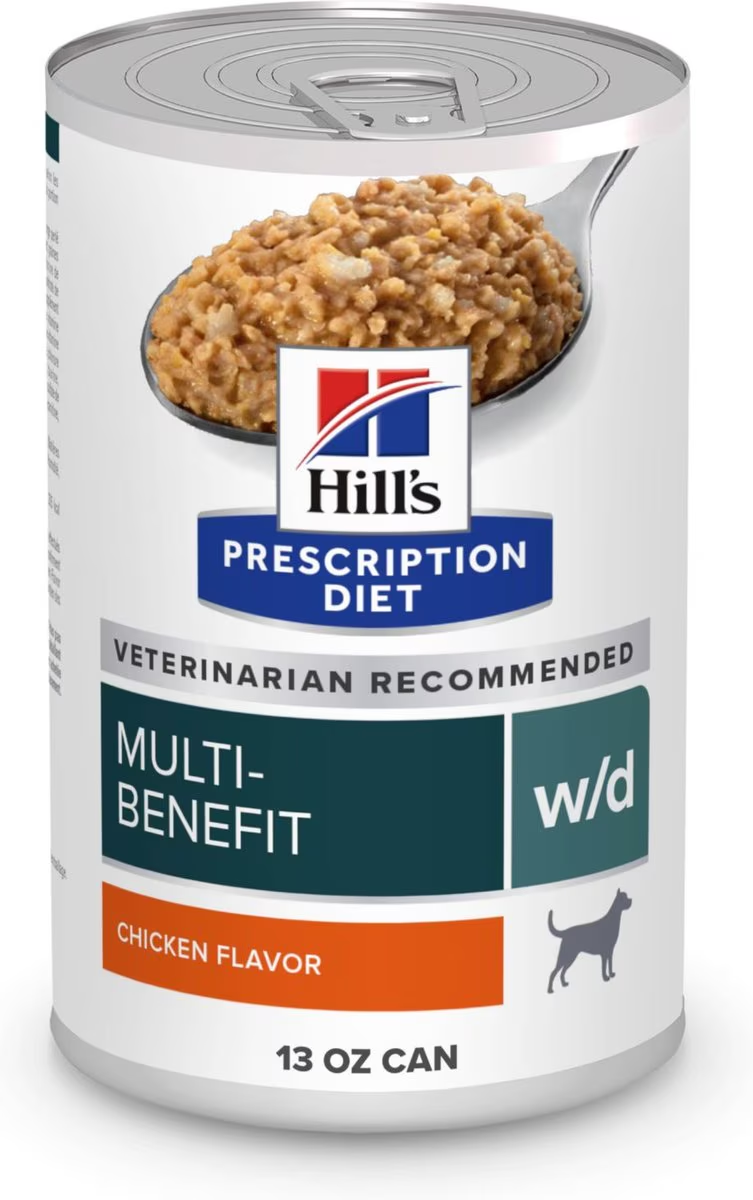
DogFoodAdvisor is reader supported See how
All reviews are 100% impartial but if you buy using links on this page, we may earn a referral fee.
Our Verdict
Hill’s Prescription Diet wet product range is made up of 36 recipes which are not rated due to their intentional therapeutic design. All the recipes in Hill’s Prescription Diet Wet range are designed for specific health conditions.
Although this is a prescription product, our review has nothing to do with the accuracy of claims made by the manufacturer as to the product’s ability to treat or cure a specific health condition.
So, to find out whether or not this product is appropriate for your particular pet, it’s important to consult with your veterinarian.
Pros
- Wide variety of recipes for specific needs
- More affordable than some high-end dog food
- Science led ingredients
Cons
- Recipes contain fillers and potentially controversial ingredients
The table below shows each recipe in this range and the AAFCO nutrient profile: Growth (puppy), Maintenance (adult), All Life Stages, Supplemental or Unspecified.
Ingredients Analysis
Hill’s Prescription Diet w/d Multi-Benefit Chicken Flavor Wet Dog Food (formulated as a multi-benefit) has been chosen as a representative of the range, even though each recipe may be designed for different veterinary conditions.
The first ingredient in this dog food is water, which adds nothing but moisture to this food. Water is a routine finding in most wet dog foods.
The second ingredient is pork liver. This is an organ meat sourced from a named animal and thus considered a beneficial component.
The third ingredient is corn. Corn is an inexpensive and controversial cereal grain. And aside from its energy content, this grain is of only modest nutritional value to a dog.
The fourth ingredient lists chicken. Chicken is considered “the clean combination of flesh and skin… derived from the parts or whole carcasses of chicken”.1
Chicken is naturally rich in the 10 essential amino acids required by a dog to sustain life.
The fifth ingredient is cracked pearled barley. Cracked Pearled Barley is produced when the seed hull and bran is removed from barley grain. Fiber is distributed throughout the barley grain, rather than being contained within the hull meaning that Cracked Pearled Barley is still a source of fiber. However, aside from its energy content, this cereal grain is of only modest nutritional value to a dog.
The sixth ingredient is powdered cellulose, powdered cellulose, a insoluble plant fiber usually made from the by-products of vegetable processing. As a fiber isolate cellulose can convey a number of functional benefits in the diet, from reducing the energy density and promoting satiety in a weight control diet, to supporting digestion and dental health.
The seventh ingredient is chicken liver flavor. Many chicken liver flavors are made from the enzymatic breakdown of liver tissue. Chicken liver is incredibly palatable and so often included within flavor enhancers.
The eighth ingredient is flaxseed, one of the best plant sources of healthy omega-3 fatty acids. Provided they’ve first been ground into a meal, flax seeds are also rich in soluble fiber.
However, flaxseed contains about 19% protein, a factor that must be considered when judging the actual meat content of this dog food.
The ninth ingredient is egg product, an unspecified (wet or dry?) form of shell-free eggs. Quality can vary significantly. Lower grade egg product can even come from commercial hatcheries – from eggs that have failed to hatch.
In any case, eggs are easy to digest and have an exceptionally high biological value.
The next ingredient is soybean oil, which is red flagged here only due to its rumored (yet unlikely) link to canine food allergies.
However, since soybean oil is high in omega-6 fatty acids and contains no omega-3s, it’s considered less nutritious than flaxseed oil or a named animal fat.
From here, the list goes on to include a number of other items.
But to be realistic, ingredients located this far down the list (other than nutritional supplements) are not likely to affect the overall rating of this Hill’s product.
With two notable exceptions.
First, the minerals listed here do not appear to be chelated. And that can make them more difficult to absorb. Chelated minerals are usually associated with higher quality dog foods.
We also note the use of taurine, an important amino acid associated with the healthy function of heart muscle. Although taurine is not typically considered essential in canines, some dogs have been shown to be deficient in this critical nutrient.
hills Dog Food Recall History
The following automated list (if present) includes all dog food recalls related to hills through April 2025.
- Hill’s Prescription Diet and Science Diet Dog Food Recall Expands to Include 44 Varieties (March 20, 2019)
- Hill’s Prescription Diet and Science Diet Dog Food Recall (January 31, 2019)
- Hill’s Science Diet Dog Food Market Withdrawal of November 2015 (November 29, 2015)
- Hill’s Science Diet Dog Food Recall June 2014 (June 3, 2014)
You can view a complete list of all dog food recalls since 2009 here.
Our Rating of Hill's Prescription Diet Wet Dog Food
Hill’s Prescription Diets offer a variety of tailored foods designed to address specific medical concerns. Hill’s understands that dogs with health issues require a different balance of proteins, vitamins, and fibers to support their internal functions which may be under strain.
Dogs with kidney, joint, skin, weight, and digestion issues can benefit from a specially formulated Hill’s diet that supports and nourishes these specific areas of the body.
About
Hill’s Pet Nutrition is an international pet food brand that’s known for selling scientifically developed foods.
In 1948, Hill’s officially went into business. Dr. Mark Morris Sr. teamed up with Topeka-based Hill Packing Company to can his recipe, Canine k/d, and produce new pet food formulas.
In 1968, Hill’s launched its Science Diet range under the guidance of Mark Morris Jr. In 1976, Colgate-Palmolive Co. purchased Hill’s Pet Nutrition. Today, Hill’s products are available in 86 countries worldwide.
It now employs a team of more than 220 veterinarians, nutritionists, technicians, and food scientists to develop pet foods in the Hill research facility that’s still located in Topeka.
Compare Hill's Prescription Diet Wet Dog Food
How does Hill's Prescription Diet Wet compare with The Dog Food Advisor's most recommended brands?
A Final Word
The Dog Food Advisor does not accept money, gifts, samples or other incentives in exchange for special consideration in preparing our reviews.
However, we do receive a referral fee from online retailers (like Chewy or Amazon) and from sellers of perishable pet food when readers click over to their websites from ours. This helps cover the cost of operation of our free blog. Thanks for your support.
For more information, please visit our Disclaimer and Disclosure page.





